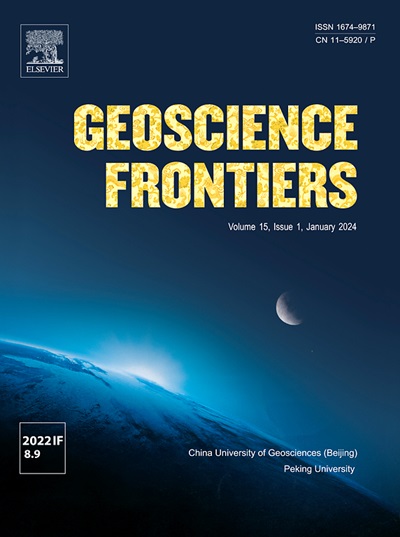印度-亚洲大陆辐合边缘地热水中的锂同位素:来源与演化
IF 8.9
1区 地球科学
Q1 GEOSCIENCES, MULTIDISCIPLINARY
引用次数: 0
摘要
印度-亚洲大陆辐合边缘地热水中的锂是一种潜在的锂资源,在河流和海洋的锂收支和锂同位素组成(δ7Li)中起着重要作用。然而,它的起源和行为仍不清楚。本文系统研究了藏南和喜马拉雅地区21个地热水样品以及一系列浅层地下水和河流水样品的δ7Li、水(δ18O和δ2H)和氦(3He/4He)同位素。地热水δ7Li值变化范围为+1.0‰~ +14.3‰,与Li浓度(0.006 ~ 35.0 mg/L)呈负相关。5 mg/L地热水中,Li主要来源于地壳花岗质岩浆房溶蚀的岩浆流体,而非地幔,贡献为49.5%±3.2% ~ 85.5%±1.0%。富锂地热水的δ7Li值相对均匀,与大块花岗岩的δ7Li值相当。它们主要受花岗岩岩浆流体中Li同位素组成(−2.6‰~ +5.6‰)和深层地热储层(4.4 ~ 7.9 km)高温(174±5℃~ 315±6℃)水-花岗岩相互作用过程中原生矿物的溶蚀和微量Li同位素分馏的次生矿物的沉淀控制。对于锂浓度为5 mg/L的地热水,锂主要来源于106±3°C至207±10°C的水-花岗岩相互作用(以黑云母溶解为主),约占总锂的85%±16%。综合溶解-降水-混合模型表明,贫锂样品的高δ7Li值是由于浅层储层(2.7 ~ 5.2 km)较低储层温度下6Li优先掺入次生矿物以及地热水上升过程中浅层地下水的混合作用所致。本研究为地壳花岗岩浆房流体地球化学提供了新的认识,强调了西藏富锂地热水受地壳花岗岩浆房的存在和断裂规模的控制。本文章由计算机程序翻译,如有差异,请以英文原文为准。

Lithium isotopes in the geothermal waters of the India–Asia continental convergent margin: Source and evolution
Lithium (Li) in geothermal waters along the India–Asia continental convergent margin is a potential Li resource and plays an important role in the Li budget and Li isotopic composition (δ7Li) of rivers and oceans. However, its origins and behavior remain unclear. Here, we systematically investigated the δ7Li, water (δ18O and δ2H) and helium (3He/4He) isotopes of 21 geothermal water samples as well as a series of shallow groundwater and river water samples from southern Tibet and the Himalayas. The δ7Li values of geothermal waters vary from +1.0‰ to +14.3‰ and are negatively correlated with the Li concentration (0.006–35.0 mg/L). For geothermal water with Li concentrations >5 mg/L, Li is sourced mainly from magmatic fluids exsolving from granitic magma chambers in the crust rather than the mantle, with contributions of 49.5% ± 3.2% to 85.5% ± 1.0%. The δ7Li values of these Li-rich geothermal waters are relatively homogeneous and comparable to those of bulk granitic rocks. They are mainly controlled by the Li isotopic compositions of granitic magmatic fluids (−2.6‰ to +5.6‰), and the dissolution of primary minerals and the precipitation of secondary minerals with minimal Li isotopic fractionation during high-temperature (174 ± 5 °C to 315 ± 6 °C) water–granite interactions at deep geothermal reservoirs (4.4–7.9 km). For geothermal waters with Li concentrations <5 mg/L, Li originates primarily from water–granitic rock interactions (dominated by biotite dissolution) at 106 ± 3 °C to 207 ± 10 °C, contributing approximately 85% ± 16% of the total Li. An integrated dissolution–precipitation–mixing model suggests that high δ7Li values in Li-depleted samples result from preferential incorporation of 6Li into secondary minerals at lower reservoir temperatures within shallower reservoirs (2.7–5.2 km) and mixing of shallow groundwater during the ascent of geothermal waters. This study provides new insights into the fluid geochemistry of crustal granitic magma chambers and highlights that Li-rich geothermal waters in Tibet are controlled by the existence of crustal granitic magma chambers and the scale of faults.
求助全文
通过发布文献求助,成功后即可免费获取论文全文。
去求助
来源期刊

Geoscience frontiers
Earth and Planetary Sciences-General Earth and Planetary Sciences
CiteScore
17.80
自引率
3.40%
发文量
147
审稿时长
35 days
期刊介绍:
Geoscience Frontiers (GSF) is the Journal of China University of Geosciences (Beijing) and Peking University. It publishes peer-reviewed research articles and reviews in interdisciplinary fields of Earth and Planetary Sciences. GSF covers various research areas including petrology and geochemistry, lithospheric architecture and mantle dynamics, global tectonics, economic geology and fuel exploration, geophysics, stratigraphy and paleontology, environmental and engineering geology, astrogeology, and the nexus of resources-energy-emissions-climate under Sustainable Development Goals. The journal aims to bridge innovative, provocative, and challenging concepts and models in these fields, providing insights on correlations and evolution.
 求助内容:
求助内容: 应助结果提醒方式:
应助结果提醒方式:


